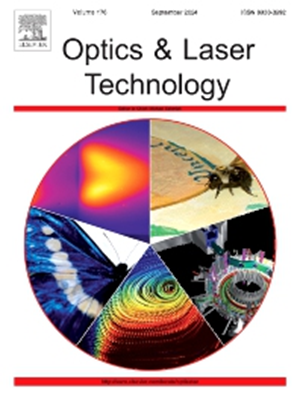大衍射和畸变密集激光条纹的像素校正与测量方法
IF 4.6
2区 物理与天体物理
Q1 OPTICS
引用次数: 0
摘要
激光三维扫描仪被广泛应用于复杂场景的三维形状获取。激光三维扫描仪的条纹越多,测量效率越高。然而,密集激光条纹(DLS)(超过20个激光条纹)导致大角度衍射,增加了制造畸变,严重降低了DLS三维扫描仪的精度。为了解决这一问题,我们提出了一种DLS三维扫描仪的像素化校准和测量方法。在校准时,将DLS投影到校准工具上。两个摄像机捕捉变形的DLS图案。我们使用立体校正和中心提取来获得两种图案中每个条纹的中心点。然后,将标定工具移动到不同的距离,得到不同距离上各条纹的中心点。我们为每个条纹的每一行选择不同距离的中心点,并利用这些中心点在成像平面上的一个变量的三次方程来建模两个相机之间的关系。我们对所有条纹行重复此过程,以创建两台相机和DLS之间的像素关系。实验结果表明,该方法的平均标定精度比平面模型高96%,比三维二次曲面模型高92%。在测量中,我们利用校准后的DLS系统来提高测量精度。中心点用标定参数逐行、逐条、逐条进行最小二乘迭代校正。实验结果表明,与立体重建结果相比,标准球体的测量精度提高了40%,低反射率物体的测量精度提高了74%。本文章由计算机程序翻译,如有差异,请以英文原文为准。
Pixelwise calibration and measurement method of dense laser stripes with large diffraction and distortion
Laser three-dimensional (3D) scanner is widely used to obtain the 3D shapes in complex scenes. The more stripes of laser 3D scanner, the higher measurement efficiency. However, dense laser stripes (DLS) (more than 20 laser stripes) causes large angle diffraction and increases the manufacturing distortion, which significantly decreased the accuracy of the DLS 3D scanner. To address this issue, we propose a pixelwise calibration and measurement method for DLS 3D scanner. In calibration, the DLS are projected onto a calibration tool. Two cameras capture the deformed DLS patterns. We use the stereo rectification and center extraction to obtain the center points of each stripe in two patterns. Then, we move the calibration tool to different distances, and obtain the center points of each stripe in different distances. We select the center points at different distances for each row of each stripe, and model the relationship between two cameras by a cubic equation in one variable in the imaging plane with these center points. We repeat the process for all the rows of stripes, so as to create the pixelwise relation between the two cameras and DLS. The experimental results show that the mean calibration accuracy of the proposed method is 96% higher than that of the planar model and 92% higher than that of the 3D quadratic surface model. In measurement, we take advantage of the calibrated DLS system to increase the measurement precision. The center points are corrected with the calibrated parameters row by row, stripe by stripe using least squares iterations. The experimental results show that the measurement accuracy of the standard spheres increased by 40% and that of low-reflectivity objects increased by 74% compared to the results of stereo reconstruction.
求助全文
通过发布文献求助,成功后即可免费获取论文全文。
去求助
来源期刊
CiteScore
8.50
自引率
10.00%
发文量
1060
审稿时长
3.4 months
期刊介绍:
Optics & Laser Technology aims to provide a vehicle for the publication of a broad range of high quality research and review papers in those fields of scientific and engineering research appertaining to the development and application of the technology of optics and lasers. Papers describing original work in these areas are submitted to rigorous refereeing prior to acceptance for publication.
The scope of Optics & Laser Technology encompasses, but is not restricted to, the following areas:
•development in all types of lasers
•developments in optoelectronic devices and photonics
•developments in new photonics and optical concepts
•developments in conventional optics, optical instruments and components
•techniques of optical metrology, including interferometry and optical fibre sensors
•LIDAR and other non-contact optical measurement techniques, including optical methods in heat and fluid flow
•applications of lasers to materials processing, optical NDT display (including holography) and optical communication
•research and development in the field of laser safety including studies of hazards resulting from the applications of lasers (laser safety, hazards of laser fume)
•developments in optical computing and optical information processing
•developments in new optical materials
•developments in new optical characterization methods and techniques
•developments in quantum optics
•developments in light assisted micro and nanofabrication methods and techniques
•developments in nanophotonics and biophotonics
•developments in imaging processing and systems

 求助内容:
求助内容: 应助结果提醒方式:
应助结果提醒方式:


